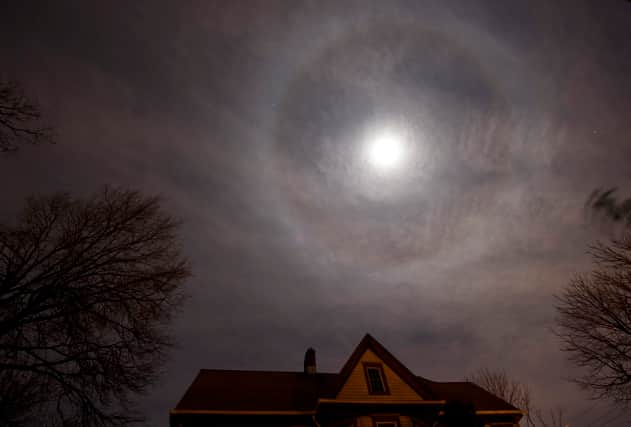Lunar halo: moon phenomenon explained, meaning, will there be one in the UK tonight - does it mean snowfall?


A celestial "lunar halo" adorned the night sky this weekend, casting a ring around the Moon.
The captivating sight graced the skies on Saturday evening (25 November), visible in various locations including Staffordshire, the West Midlands, Surrey, Berkshire, Dorset, Yorkshire, Cumbria, Derbyshire, and the Isle of Wight.
Advertisement
Hide AdAdvertisement
Hide AdBut what exactly is a lunar halo? How does one form, and will you be able to see one tonight? Here is everything you need to know about it.
What is a lunar halo?
A lunar halo is an optical phenomenon that occurs around the Moon when moonlight is refracted or bent by ice crystals in the upper atmosphere. These hexagon-shaped ice crystals act like prisms, refracting the light and creating a circular halo around the Moon.
The halo often appears as a luminous ring or circle surrounding the Moon and can sometimes have a faint rainbow-like colouring on the inside edge.
Folklore often associates these halos with upcoming changes in weather, but they're primarily a result of the interaction between moonlight and atmospheric ice crystals.
Advertisement
Hide AdAdvertisement
Hide AdWhat conditions are needed for them to form?
Lunar halos are similar to solar halos, which occur around the Sun, but they're generally less common and more subtle.
They form under specific atmospheric conditions that involve the presence of high-altitude cirrus clouds which are made up of tiny ice crystals suspended high in the atmosphere, typically above 20,000 feet.
The crystals need to be hexagonally shaped and oriented in a particular way to create the halo effect. While the cirrus clouds need to be present, the sky around the Moon must be relatively clear for the halo to be visible.
Lunar halos are most commonly observed when the Moon is full or close to full, as the moonlight is bright enough to illuminate the ice crystals and create the halo effect.
Advertisement
Hide AdAdvertisement
Hide AdThey are less common than solar halos, due to the specific conditions required for their formation, but while they're not an everyday occurrence, they're also not extremely rare.
What do lunar halos 'mean'?
In some cultures, there's a belief that a lunar halo signals the approach of a weather change, often predicting rain or stormy weather within a couple of days. This belief stems from the high-altitude cirrus clouds needed for the halos to form, which often precede weather systems that bring precipitation.
Some superstitions view lunar halos as omens or signs of impending change or events. Interpretations can vary widely, from predictions of good luck or fortune to warnings of impending disasters or conflicts.
While these beliefs and interpretations are rooted in cultural traditions, there's no scientific evidence to support the idea that lunar halos directly cause weather changes or predict specific events.
Advertisement
Hide AdAdvertisement
Hide AdWill there be a lunar halo tonight?
Predicting the occurrence of a lunar halo for a specific night can be challenging as it depends on various atmospheric conditions.
However, if the sky is clear or partly cloudy and there are high-altitude cirrus clouds present, especially around a full or nearly full moon, there might be a chance of witnessing a lunar halo.
Checking local weather forecasts or sky conditions closer to the evening might give you a better idea of the atmospheric conditions conducive to the formation of a lunar halo.
Comment Guidelines
National World encourages reader discussion on our stories. User feedback, insights and back-and-forth exchanges add a rich layer of context to reporting. Please review our Community Guidelines before commenting.
